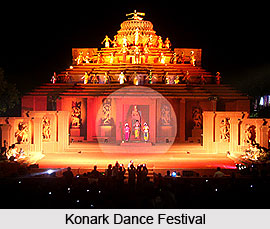 Among all the Indian dance festivals, Konark Dance Festival has gained recognition because of its venue. The dance festival is organised in the setting of the `Sun temple` in Konark. The temple is a world heritage site and possesses splendid `Natyamandir` or the `dancing hall`. This 700-year old shrine is an architectural marvel and is adorned with sculptures of musicians playing drums, cymbals and other musical instruments along with carving of Odissi dance poses. The dance festival is organised in December annually and is a joyous festival of classical dance and music. The festival is jointly organised by Orissa Tourism and Odissi Research Centre.
Among all the Indian dance festivals, Konark Dance Festival has gained recognition because of its venue. The dance festival is organised in the setting of the `Sun temple` in Konark. The temple is a world heritage site and possesses splendid `Natyamandir` or the `dancing hall`. This 700-year old shrine is an architectural marvel and is adorned with sculptures of musicians playing drums, cymbals and other musical instruments along with carving of Odissi dance poses. The dance festival is organised in December annually and is a joyous festival of classical dance and music. The festival is jointly organised by Orissa Tourism and Odissi Research Centre.
The open-air auditorium and the incredible performances of the classical dances such as Odissi, Bharathnatyam, Manipuri and Kathak as well as dances like Chau present an enthralling site. Konark Dance Festival is graced by a host of celebrated dancers from all over the country. The audience can enjoy the reverberating sound of Ghungroo bells flute and Pakhauj. The festival can be termed as a classical extravaganza through eternal ecstasy.
Furthermore, Konark Dance Festival is the platform for both to the performing artiste and the dance connoisseur. The festival enables the audience to appreciate the performance. In addition to that budding dancers get an opportunity to showcase their talent and develop their latent skill. The festival is well admired by the tourists from the country as well as from abroad too. The Natya Mandir (Dance Hall) is situated on the Chandrabhaga Beach; Konark attracts tourists from all over the country.
The visitors can take pleasure in the Konark Dance Festival and apprise the elegant gestures, sensuous body language, and expressive faces of the dancers. This mega event exhibits the best of the traditional and classical dance forms of India. The dance festival also promotes the rich cultural and dance heritage of the country. The leading maestros and dance enthusiasts of the classical dance forms of India which include Odissi, Bharatanatyam, Manipuri, Kathakali, and Chao, take part in the five-day classical dance carnival adding to the appeal of the event.
The Konark Dance Festival is also a scene for a crafts mela. A variety of handicrafts and tasty cuisine during the festival are exhibited. The visitors get the opportunity of buying sculptures and souvenirs which are the showmanship of the expert craftsmen of the region.



















